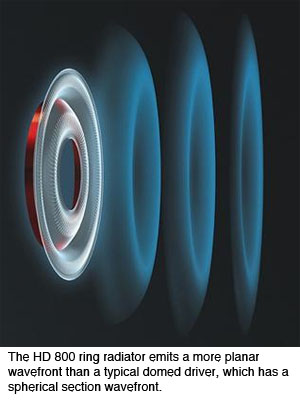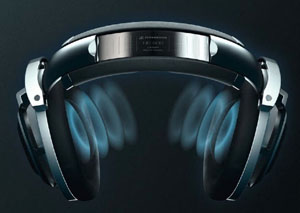| Columns Retired Columns & Blogs |
The Brilliant Sennheiser HD 800

This story originally appeared at InnerFidelity.com
The Sennheiser HD 800 ($1499)
I had the good fortune of a factory visit to Sennheiser's campus in Wennebostel, Germany sometime in 2005--four years before the HD 800 made its appearance at the 2009 Consumer Electronics Show, the HD 800 was already heavily under development. We'll never know, of course, but I reckon these headphones have more R&D hours invested in them than any other on the planet. The engineers at Sennheiser were given a "clean slate" to develop the world's best dynamic headphone. At the time of my visit, the dialog mostly centered on developing large diaphragm drivers for dynamic headphones that would deliver a flatter wave-front as it approached the ear and that wouldn't suffer "cone break-up." It was obvious to me they were also having the time of their lives with the whole variety of issues surrounding headphone design, and were up to their necks in all manner of design ideas and visions. Interestingly, the final product was very unlike what I saw on computer screens that day in 2005--the sound, however, is not unlike what I had imagined: simply spectacular.
The Sennheiser HD 800 is a full-size, open headphone with rather large earpieces, which fully, easily, and very comfortably encompass the ears. The ear cushions are a micro-fiber material that is cool and comfortable. An easily removable and hand-washable cloth protector covers the inside of the earpieces. A permanently installed synthetic mesh material covers and protects the driver from dirt and hair. The main earpiece housings are a framework cast of Leona plastic--a 60% glass fiber filled, high stiffness specialized plastic. A very fine acoustically transparent stainless steel mesh is supported by the framework, as well. A bail/gimbal assembly attaches the headband to the rear of each earpiece, and has two pivot points that allow adequate freedom for the earpiece to tilt and swivel to align with the side of the head for a proper fit. The headband has a middle section that includes a comfortable pad made from the same material as the earpads. Sennheiser claims the headband has features that provide a significant amount of vibrational damping. The cable's conductors are OFC (oxygen free copper) in a "Y" configuration, and are attached to each earpiece with some very nice connectors. A large and very nice custom 1/4" stereo headphone plug is at the other end of the cable. There is no 1/4" to 1/8" adapter for use with portable players and the like.
Ring Radiator Driver
 The major technological advance in the Sennheiser HD 800 is the "ring radiator" driver. This driver delivers a couple of advantages: it reduces "cone breakup," which causes distortion at high frequencies; and it provides better imaging by being angled back towards the ears from a slightly forward position thereby emitting a rather more planar wave front than a normal headphones driver.
The major technological advance in the Sennheiser HD 800 is the "ring radiator" driver. This driver delivers a couple of advantages: it reduces "cone breakup," which causes distortion at high frequencies; and it provides better imaging by being angled back towards the ears from a slightly forward position thereby emitting a rather more planar wave front than a normal headphones driver.
A regular driver diaphragm has a dome in the middle; the voice coil about half way to the edge; and a surround or suspension outside the voice coil that has a fixed attachment to the driver housing around its outside edge. The problem with this type of driver is that at very high frequencies it may stop acting like a pure piston moving only straight in and out, and may take on additional vibration modes so that the surface is wobbling or twisting as it moves in and out. This is called "cone break-up" in speakers.
The traditional approach to solving this problem is to make the speaker cone, or driver diaphragm in this case, stiffer so it is less likely to begin vibrating on its own. This is where you find folks making aluminum speaker cones, or cones with ridges and various features to make it more rigid. Sennheiser developed its Duofoil diaphragm material (used in many of its high-performance headphones) to combat this problem. Unfortunately this often leads to a heavier cone that is more difficult to accelerate, and therefore lowers the slew rate (transient response) of the driver.
 Recently, another approach appeared commercially, called a "ring radiator." Both Scan-Speak and Vifa produce a version of this type of tweeter. In this case, the driver is not a simple circular driver, but a ring shaped driver which is attached both at its outer circumference and at its inner edge. The diaphragm is driven by the voice coil which is attached behind the "V"-shaped groove halfway between its inner and outer edge. This configuration dramatically increases the amount of structural support for the surface area of the driver, and reduces to amount of surface area that can begin to take on its own vibrations.
Recently, another approach appeared commercially, called a "ring radiator." Both Scan-Speak and Vifa produce a version of this type of tweeter. In this case, the driver is not a simple circular driver, but a ring shaped driver which is attached both at its outer circumference and at its inner edge. The diaphragm is driven by the voice coil which is attached behind the "V"-shaped groove halfway between its inner and outer edge. This configuration dramatically increases the amount of structural support for the surface area of the driver, and reduces to amount of surface area that can begin to take on its own vibrations.
Because the new driver could become larger without breaking up, we also get two other sonic benefits: tighter bass and better imaging. A larger driver allows the diaphragm to displace more air for any given unit distance moved compared to a smaller driver. Moving more air means the driver can achieve better bass extension before it runs out of voice coil travel. It's pretty obvious when listening to these cans, they really have an astonishing sense of ease and control in the lows.
 The second advantage the new ring radiator has in the HD 800 is improved imaging, a better sense of coherence. Normally, sound arriving at your head from a source some distance away is essentially a flat wavefront. With typical dome driver headphones, the sound source is very close to your ears, and the wavefront is still fairly spherical when it hits you outer ear. It is argued, in headphone engineering circles, that the outer ear focuses the two wavefront geometries differently into the ear canal; and that the more curved wavefront of typical headphones causes psycho-acoustic problems resulting in poorer imaging.
The second advantage the new ring radiator has in the HD 800 is improved imaging, a better sense of coherence. Normally, sound arriving at your head from a source some distance away is essentially a flat wavefront. With typical dome driver headphones, the sound source is very close to your ears, and the wavefront is still fairly spherical when it hits you outer ear. It is argued, in headphone engineering circles, that the outer ear focuses the two wavefront geometries differently into the ear canal; and that the more curved wavefront of typical headphones causes psycho-acoustic problems resulting in poorer imaging.
With normal speaker listening, the wavefront is hitting the side of your head and ears at an angle. To mimic this geometry, Sennheiser mounts the HD 800 drivers slightly forward of your ears, and slightly angled back towards them. The larger diameter and angled geometry of the HD 800 driver produces a wavefront that arrives at the ears in a more natural way than with traditional headphones and allows more of the normal reflections at the outer ear to occur, which allows the brain to understand and localize the sound it's hearing significantly better. The result is significantly improved imaging.
So, how do they sound?
- Log in or register to post comments




































